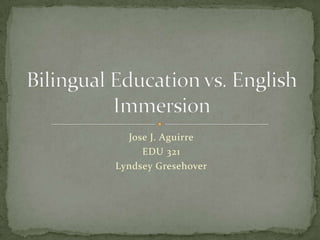
Bilingual education
- 1. Jose J. Aguirre EDU 321 Lyndsey Gresehover
- 2. The use of two languages in school by students or by teachers. “It refers to approaches in the classroom that use the native languages of English language learners (ELLs) for instruction” (NABE, 2009). Goals include teaching English, acculturating immigrants to a new society, etc.
- 3. An English-only program where instruction is provided exclusively in English. Children with low English proficiency get automatically put into ESL classes. There are two different types of immersion programs: “submersion” and “structure”. Submersion program is also known as “sink or swim” due to the lack of aid for children learning English. Structure programs are better because it focuses in helping kids develop strong vocabularies.
- 4. “Bilingual approaches to education were more effective than English only immersion programs” (Williams, 2010). Research has found that those programs that teaching reading in the student’s native language and teach English at the same time are the most effective. Stephen Krashen and Jim Cummings both agree that when material is presented to student in their native language, they will learn faster .
- 5. Those who oppose bilingual education believe that the best way for ELL students to succeed is to completely immersing them in the English language. Bilingual education is expensive. Bilingual education leads to the segregation of non English speakers. In some areas of the country, the bilingual programs is unpractical due to the number of different native languages the students may speak.
- 6. Allows ESL students to learn the English language faster, because they will be completely immerse in it. Observing students will learn faster from their teachers looking at their speaking styles and body language during core subjects lessons Children learn more efficiently when exposed to other English speaking students, rather than only English speaking authorities.
- 7. Students may not understand other native speakers in classes, making him hard to socialize. Students who doesn’t understand the English language may have problems with the subjects exams and exercises in classes. English submersion poses the risk of a student “sinking” rather than “learning to swim”.
- 8. Total immersion: programs on which all subjects in the lower grades are taught in the target language. Initial literacy is provided in the target language. Partial Immersion: program in which about 50% of the subjects is taught in the target language. Initial literacy may be provided in the target language, English or both simultaneously. Two-way immersion: Use both English and another language for instruction.
- 9. Sink or swim vs. being taught on native language Total immersion on the English language vs. slow but steady teaching from bilingual education. Learning the proper way or not at all vs. having teachers with low standards (ESL). Having kids with low English proficiency with English only students vs. segregating ELL students. Integrating an English only lesson plan vs. adhering to the students native tongues.
- 12. CAL. (2007). Foreign Language Immersion Programs Features and Trends over 35 years. http://www.cal.org/resources/digest/flimmersion.html Chen, G. (2008). Full Language Immersion Programs in Public Schools. http://www.publicschoolreview.com/articles/25 Echevarria, J. & Graves, A. (2011). Sheltered content instruction: Teaching English learners with diverse abilities (4th ed.). Boston, MA: Pearson Education, Inc. NABE. (2009). Bilingual Education. http://www.nabe.org/BilingualEducation
